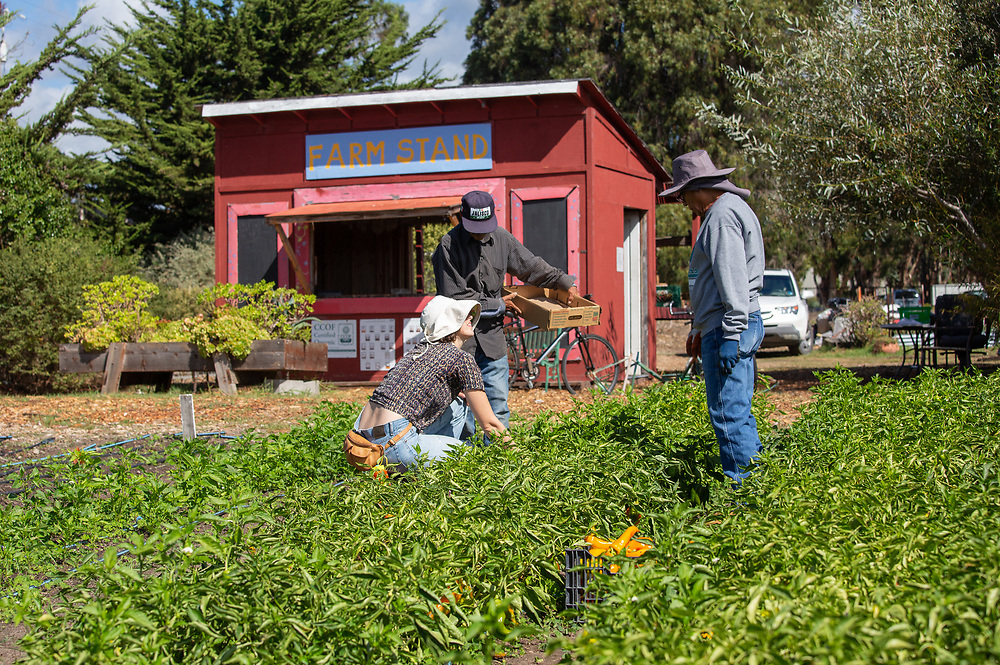Natural Bridges Farm
The Homeless Garden Project has been at the Natural Bridges Farm location since 1995. This is our core location which is actively being farmed and utilized for our programs.
Our organic farm has a social purpose of giving people experiencing homelessness a second chance in life. In 2016, HGP launched a successful capital campaign to raise funds for a permanent home, and future options are now being considered. The Natural Bridges Farm, where trainees and volunteers work, was the first CSA in the county and had been producing some of the best organic produce in Santa Cruz since 1995.
Visitors Welcome!
The Natural Bridges Farm is 3.5 Acres in Size
Located on Shaffer Road in Santa Cruz
Come By the Farm Stand
Pick from our abundant selection of seasonal vegetables
Open Tues-Fri (8am-4:30pm), Sat & Sun (10am-4pm), Mon closed
For visitors
Community Supported Agriculture
The Homeless Garden Project has been at the Natural Bridges Farm location since 1995. This is our core location which is actively being farmed and utilized for our programs.
Our organic farm has a social purpose of giving people experiencing homelessness a second chance in life. In 2016, HGP launched a successful capital campaign to raise funds for a permanent home, and future options are now being considered. The Natural Bridges Farm, where trainees and volunteers work, was the first CSA in the county and had been producing some of the best organic produce in Santa Cruz since 1995.
Community Supported Agriculture (CSA) is a way to buy local food directly from a farmer. You purchase a “share” and become a farm “member.”
The farm produces a box of seasonal vegetables, culinary herbs, and flowers weekly throughout the season. However, CSA is much more than just a weekly box of veggies.
CSA is a powerful investment in your health, local community, and economy. It’s a partnership between farms and consumers that helps families eat seasonal, local produce, implement a solution to climate change through organic agriculture, and entrusts farmers and consumers with the responsibility of building a resilient, equitable food system.

Yes. The Homeless Garden Project Natural Bridges Farm has been Certified Organic through the California Certified Organic Farmers (CCOF) since 1991. We are proud that our organic techniques enhance the local natural environment and demonstrate agriculture practices that are one of the key solutions to climate change.
There are many benefits of organic agriculture. They include:
- The promotion of biodiversity
- Improvement to soil health such as carbon sequestering
- Building organic and mineral matter
- Encouraging soil microorganism growth
We don’t depend on the use of chemical pesticides or herbicides, which supports a healthier environment and a source of healthier, fresh food for local communities. Other benefits of our organic, small scale approach ripple into our local community and natural environment.

Our CSA and organic techniques foster relationships. Beyond connecting consumers to their food source, our farm reinforces the social fabric between our Santa Cruz urban and rural areas. Our farm nurtures the support and growth of the vibrant Santa Cruz community and helps to create an exceptional working environment for HGP ‘trainees’, while offering welcoming spaces for Santa Cruz locals and visitors.

Organic agriculture considers the medium- and long-term effect of agricultural techniques implemented. It aims to produce food, while establishing an ecological balance to promote soil fertility and prevent pest problems.
Organic agriculture takes a proactive approach as opposed to treating problems after they emerge. Explore the different impacts of organic agriculture above.

Soil degradation is among the most significant of global issues, largely caused by harmful impacts of industrial agriculture. The use of chemical inputs and fossil fuels for cultivation and transport of agricultural goods are increasingly common due to climate change and related factors.
Soil degradation is a culmination of many changes in natural phenomena and human-related activities. It impacts the topsoil’s ecological, biological, physical, and chemical characteristics. The last decade has witnessed a depletion in soil quality and erosion resulting in loss of soil fertility, microbiota, and ecological balance.
At the Homeless Garden Project we work tirelessly to demonstrate techniques to reverse this trend through organic farming. That's why HGP implements soil building practices such as:
- Crop rotations
- Inter-cropping
- Symbiotic associations
- Cover crops
- Organic fertilizers
- Minimum tillage
These encourage soil fauna and flora, improving soil formation and structure, and creating more stable systems. In turn, nutrient and energy cycling is increased and the retentive abilities of the soil for nutrients and water are enhanced, compensating for the non-use of mineral fertilizers.
Such management techniques also play an important role in soil erosion control. The length of time that the soil is exposed to erosive forces is decreased, soil biodiversity is increased, and nutrient losses are reduced, helping to maintain and enhance soil productivity.
The rates of groundwater level decline in California are some of the highest in the world. About 70% of water worldwide is used for agriculture and irrigation.
At HGP we use drip irrigation to ensure efficient use of water and protect groundwater through our organic practices. Unlike other forms of irrigation, such as sprinklers that are only 65-75% efficient, drip irrigation is 90% efficient at allowing plants to use the water applied. It also reduces runoff and evaporation.
What else does drip irrigation do?
- Applies water slowly at plant root zone where it is needed most
- Prevents disease by minimizing water contact with leaves, stems, and fruit of plants
- Allows rows between plants to remain dry, improving access
- Reduces weed growth and leaching of water and nutrients below the root zone
In many agricultural areas, pollution of groundwater with synthetic fertilizers and pesticides is a major problem. The use of these are prohibited in organic agriculture, ensuring our groundwater is pollution-free.
HGP replaces synthetic fertilizers with the use of organic fertilizers (e.g. compost and green manure) and through the use of greater biodiversity (in terms of species cultivated and permanent vegetation), enhancing soil structure, as well as with water infiltration. Well managed organic systems contain better nutrient retentive abilities, and greatly reduce the risk of groundwater pollution.
Organic agriculture reduces non-renewable energy use by decreasing the use of chemical pesticides and fertilizers, as well as fossil fuels needs (these require high quantities of fossil fuel to be produced).
Organic agriculture mitigates the greenhouse effect and global warming through its ability to sequester carbon in the soil. Many management practices used in our HGP organic agriculture techniques (e.g. minimum tillage, returning crop residues to the soil, the use of cover crops and rotations, and the greater integration of nitrogen-fixing legumes), increase the return of carbon to the soil, raising productivity and increasing carbon storage.
A number of studies revealed that soil organic carbon contents under organic farming are considerably higher. The more organic carbon is retained in the soil, the higher the mitigation potential of agriculture against climate change.
As organic farmers here at HGP we are both custodians and users of biodiversity at all levels. Diverse combinations of plants and animals optimize nutrient and energy cycling for agricultural production.
At the ecosystem level, the maintenance of natural areas within and around organic fields and the absence of chemical inputs creates suitable habitats for wildlife. The frequent use of under-utilized species (often as rotation crops to build soil fertility) reduces erosion of agro-biodiversity, creating a healthier gene pool - the basis for future adaptation.
The provision of structures providing food and shelter, and the lack of pesticide use, attract new or re-colonizing species to the organic area (both permanent and migratory), including wild flora and fauna (e.g. birds) and organisms beneficial to the organic system such as pollinators and pest predators.
Healthy, diverse ecosystems are responsible for the air we breathe, the food we eat, and the natural places that we visit to nurture our bodies and minds.
They support the species that, in turn, sustain human life. Ecological services derived from the use of our organic agriculture techniques include soil forming and conditioning, soil stabilization, waste recycling, carbon sequestration, nutrients cycling, predation, pollination and habitats.
By opting for HGP’s organic fruits and vegetables, the consumer, through their purchasing power, promotes a less polluting agricultural system. The hidden costs of agriculture to the environment in terms of natural resource degradation are greatly reduced.

Pogonip Farm will be the Homeless Garden Project’s new home, organically farming within the City of Santa Cruz’s Pogonip greenbelt property. It will:
- Triple our job training capacity through a public-private partnership, growing from 17 to 50 positions each year.
- Serve as a national model
- Be the heart of our dynamic agriculture program for people who are experiencing homelessness by teaching skills that transform lives
- Provide volunteer opportunities for community members.
With A 20-year lease with three 5-year renewable terms we can focus on long-term stewardship and conservation, allowing us to plant orchards for the first time and build a world-class farm to better serve the Santa Cruz community.
Pogonip is 640 acres of meadows, woodlands, and streams now owned by the City of Santa Cruz. Once, the Ohlone People gathered in its meadows. Later, in the Mexican era, it became part of a 5000-acre rancho. In the nineteenth century, its kilns, quarries, and woodlands provided lime and lumber to build California cities.
In 1987, the rustic clubhouse was condemned, and, two years later the City of Santa Cruz bought Pogonip with the help of a state park bond. Once the city owned the land, the question became: what should they do with it? Years went by as the City looked for answers.
The city created a nine-member task force to consider options. At the first meeting, sports enthusiasts, nature lovers, equestrians and hikers all presented their dreams. By the following year the task force had whittled the options down to three:
- Leave Pogonip as is
- Allow multiple uses including hiking and horse trails, a museum, a club, and notably, a garden tended by individuals experiencing homelessness
- The second option with the addition of an 18-hole golf course and playing fields
The city voted yes to the second option.
Homeless Garden Projects’ Permanent Farm at Pogonip
The City Council approved the Pogonip Master Plan which designated a nine acre plot of fertile land for the Homeless Garden Project.

Twenty years later, we are working with our partners at the City of Santa Cruz Parks and Recreation to identify a permanent place in the Pogonip Open Space where men and women experiencing homelessness can grow, create, and prosper.




